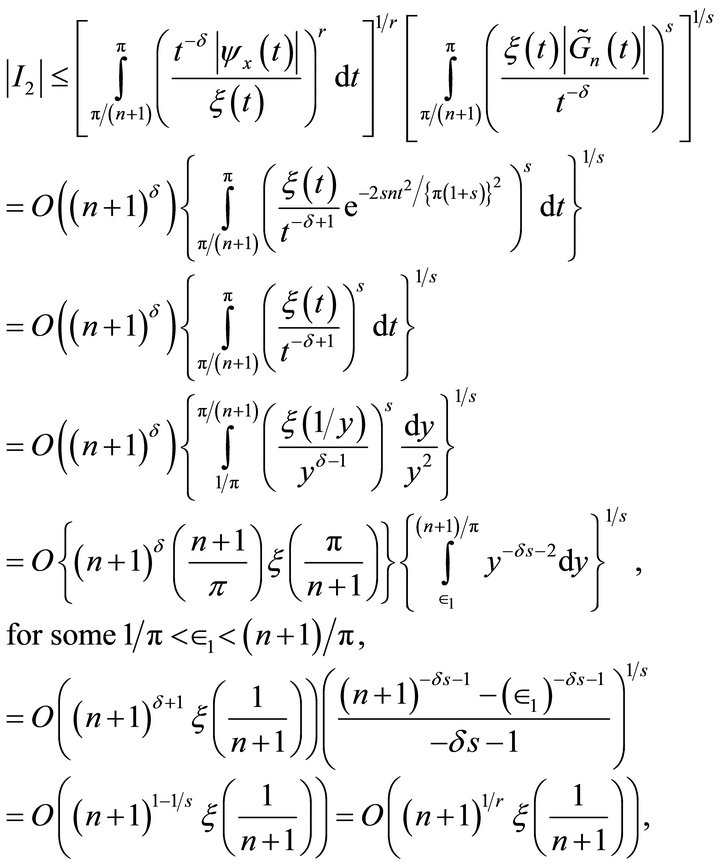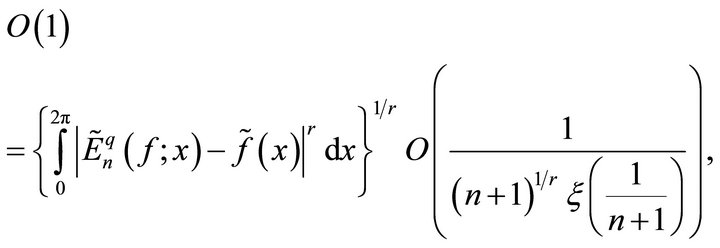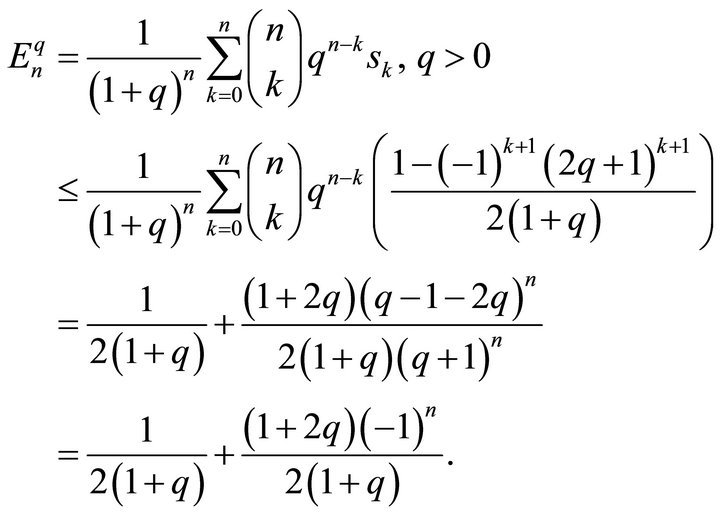Trigonometric Approximation of Signals (Functions) Belonging to the Lip(ξ(t),r),(r>1)-Class by (E,q) (q>0)-Means of the Conjugate Series of Its Fourier Series ()
1. Introduction
The theory of approximation is a very extensive field and the study of the theory of trigonometric approximation is of great mathematical interest and of great practical importance. Broadly speaking, Signals are treated as functions of one variable and images are represented by functions of two variables. The study of these concepts is directly related to the emerging area of information technology. Khan [1-4] and Mittal, Rhoades and Mishra [12] have initiated the studies of error estimates En(f) through trigonometric Fourier approximation (TFA) using different summability matrices. Chandra [7] has studied the degree of approximation of a signal (function) belonging to Lip α-class by (E,q) means, q > 0.
Generalizing the result of Chandra [7], very interesting result has been proved by Shukla [18] for the signals (functions) of  -class through trigonometric Fourier approximation by applying (E,q) (q > 0) summability matrix.
-class through trigonometric Fourier approximation by applying (E,q) (q > 0) summability matrix.
Let  be a given infinite series with sequence of its partial sums
be a given infinite series with sequence of its partial sums .
.
The  transform is defined as the
transform is defined as the  partial sum of
partial sum of  summability and we denote it by
summability and we denote it by 
If
 as
as , (1.1)
, (1.1)
then the series  is said to be
is said to be  summable to a definite number “s” [19].
summable to a definite number “s” [19].
A signal (function)  if
if
 (1.2)
(1.2)
and  [1], if
[1], if
 (1.3)
(1.3)
Given a positive increasing function 
 , if
, if
 (1.4)
(1.4)
We observe that
 (1.5)
(1.5)
The  -norm of a signal
-norm of a signal  is defined by
is defined by

The  -norm of a signal is defined by
-norm of a signal is defined by
 . (1.6)
. (1.6)
The degree of approximation of a function  by trigonometric polynomial
by trigonometric polynomial  of order “
of order “ ” under sup norm
” under sup norm  is defined by Zygmund [20].
is defined by Zygmund [20].

and  of a function
of a function is given by
is given by
 (1.7)
(1.7)
in terms of n, where  is a trigonometric polynomials of order “n”.
is a trigonometric polynomials of order “n”.
This method of approximation is called Trigonometric Fourier Approximation (TFA) [12].
Let  be a
be a  -periodic signal (function) and Lebesgue integrable. The Fourier series of
-periodic signal (function) and Lebesgue integrable. The Fourier series of  is given by
is given by
 (1.8)
(1.8)
with  partial sum
partial sum  called trigonometric polynomial of degree (order) n of the first (n + 1) terms of the Fourier series of f.
called trigonometric polynomial of degree (order) n of the first (n + 1) terms of the Fourier series of f.
The conjugate series of Fourier series (1.8) is given by
 . (1.9)
. (1.9)
We note that  is also trigonometric polynomial of degree (or order) “n”.
is also trigonometric polynomial of degree (or order) “n”.
We use the following notations throughout this paper

 .
.
2. Known Results
Chandra [7] has studied the degree of approximation to a function  by
by  of Fourier series (1.8) by proving the following theorem. He proved:
of Fourier series (1.8) by proving the following theorem. He proved:
Theorem 2.1 The degree of approximation of a periodic function f(x) with period  and belonging to the class
and belonging to the class  by Euler’s mean of its Fourier series is given by
by Euler’s mean of its Fourier series is given by
 (2.1)
(2.1)
where  is the
is the  Euler mean of order q > 0 of the sequence
Euler mean of order q > 0 of the sequence  of partial sums of the Fourier series (1.8) of the function f at a point x in
of partial sums of the Fourier series (1.8) of the function f at a point x in .
.
Shukla [18] improved Theorem 2.1 by extending to a function  by
by  matrix means of the conjugate series (1.9) of its Fourier series (1.8). He proved:
matrix means of the conjugate series (1.9) of its Fourier series (1.8). He proved:
Theorem 2.2 Let ,
, ,
, be a
be a  -periodic and Lebesgue integrable function of “t” in the interval
-periodic and Lebesgue integrable function of “t” in the interval . If
. If
 (2.2)
(2.2)
and
 (2.3)
(2.3)
where  is an arbitrary number such that
is an arbitrary number such that , s being conjugate to
, s being conjugate to  with
with , then the degree of approximation of the conjugate to a function
, then the degree of approximation of the conjugate to a function , by
, by  means,
means,  , of the conjugate series (1.9) of its Fourier series (1.8) will be given by
, of the conjugate series (1.9) of its Fourier series (1.8) will be given by
 (2.4)
(2.4)
where  is nth
is nth  mean of the sequence
mean of the sequence  of partial sums of the conjugate series (1.9) of the Fourier series (1.8) of the function f at every point x in
of partial sums of the conjugate series (1.9) of the Fourier series (1.8) of the function f at every point x in  at which
at which
 (2.5)
(2.5)
exists.
3. Main Result
The purpose of the present paper is to extend Theorems 2.1 and 2.2 on the degree of approximation of signal  conjugate to a 2π-periodic signal
conjugate to a 2π-periodic signal
 class by
class by  summability means with a proper set of conditions. More precisely, we prove:
summability means with a proper set of conditions. More precisely, we prove:
Theorem 3.1
If  conjugate to a 2π-periodic signal (function) f belonging to
conjugate to a 2π-periodic signal (function) f belonging to  -class, then its degree of approximation by
-class, then its degree of approximation by  means of conjugate series of Fourier series (1.9) is given by
means of conjugate series of Fourier series (1.9) is given by
 (3.1)
(3.1)
provided positive increasing ξ(t) satisfies the following conditions
 (3.2)
(3.2)
 (3.3)
(3.3)
and
 is non-increasing in “t”, (3.4)
is non-increasing in “t”, (3.4)
where  is an arbitrary number such that
is an arbitrary number such that
 ,
,  ,
, , condition (3.2) and (3.3) hold uniformly in x and
, condition (3.2) and (3.3) hold uniformly in x and  is the nth
is the nth  means of the series (1.9) and the conjugate function
means of the series (1.9) and the conjugate function  is defined for almost every x by
is defined for almost every x by
 (3.5)
(3.5)
Note 3.2 Using condition (3.4), we get

Note 3.3 Also, if , then our main Theorem (3.1) reduces to Theorem 2.2, and thus generalizes the theorem of Shukla [18].
, then our main Theorem (3.1) reduces to Theorem 2.2, and thus generalizes the theorem of Shukla [18].
Note 3.4 The transform (E, q) plays an important role in signal theory and the theory of Machines in Mechanical Engineering.
4. Lemma
For the proof of our theorem, we need the following lemma.
Lemma 4.1 [18]: For  we have
we have

5. Proof of Theorem 3.1
Let  denote the partial sum of series (1.9), then we have
denote the partial sum of series (1.9), then we have

Therefore the  transform
transform  of
of  is given by
is given by

(5.1)
Now, we consider

Applying Hölder’s inequality, using the fact that
 due to
due to  condition (3.2) and Lemma 4.1, we have
condition (3.2) and Lemma 4.1, we have

Since  is positive increasing function so using condition (3.4), we have
is positive increasing function so using condition (3.4), we have

 and Second Mean Value Theorem for integrals, we get
and Second Mean Value Theorem for integrals, we get

(5.2)
Now, we consider
 .
.
Again applying Hölder’s inequality, using the fact that
 due to
due to  condition (3.3) and Lemma 4.1, we obtain
condition (3.3) and Lemma 4.1, we obtain

(5.3)
in view of increasing nature of ,
, 
where  lie in
lie in , Second Mean Value Theorem for integrals and Note 3.2.
, Second Mean Value Theorem for integrals and Note 3.2.
Collecting (5.1) - (5.3), we get

Now, using the  -norm of a function, we get
-norm of a function, we get

This completes the proof of Theorem 3.1.
6. Corollaries
The following corollaries can be derived form Theorem 3.1.
Corollary 6.1: If 
 then the class
then the class
 ,
,  reduces to the class
reduces to the class ,
,
 and the degree of approximation of a function
and the degree of approximation of a function , conjugate to a
, conjugate to a  -periodic function f belonging to the
-periodic function f belonging to the  class is given by
class is given by
 (6.1)
(6.1)
Proof. Putting  in Theorem 3.1, we have
in Theorem 3.1, we have

or,

or,

For if not the right hand side of the above equation will be O(1), therefore, we have

This completes the proof of Corollary 6.1.
Corollary 6.2 If  for
for  and
and  in Theorem 3.1, then
in Theorem 3.1, then  In this case, the degree of approximation of a function
In this case, the degree of approximation of a function , conjugate to a
, conjugate to a  -periodic function f belonging to the class
-periodic function f belonging to the class  is given by
is given by

Proof. For  in Corollary 6.1, we get
in Corollary 6.1, we get

Thus, we have

This completes the proof of Corollary 6.2.
7. An Example
Consider an infinite series
 (7.1)
(7.1)
The nth partial sums  of series (7.1) at
of series (7.1) at  is given by
is given by

Since  does not exist. Therefore the series (7.1)
does not exist. Therefore the series (7.1)
is non-convergent.
Now, we have the (E,q) transform of (7.1) is given by

Here,  does not exist. Hence the series (7.1) is not summable, while the series (7.1) is product summable.
does not exist. Hence the series (7.1) is not summable, while the series (7.1) is product summable.
8. Conclusion
Several results concerning to the degree of approximation of periodic signals (functions) belonging to the Lipschitz class by matrix (E,q) operator have been reviewed. Further, a proper set of conditions have been discussed to rectify the errors. Some interesting application of the operator (E,q) used in this paper pointed out in Note 3.4. An example has been discussed also.
9. Acknowledgements
The authors are very grateful to the anonymous referees for many valuable comments and suggestions which helped to improve the presentation of the paper considerably. The authors are also thankful to all the members of editorial board of Advances in Pure Mathematics (APM) and Dr. Melody Liu, APM Editorial Board Assistant for their kind cooperation and smooth behavior during communication.
NOTES